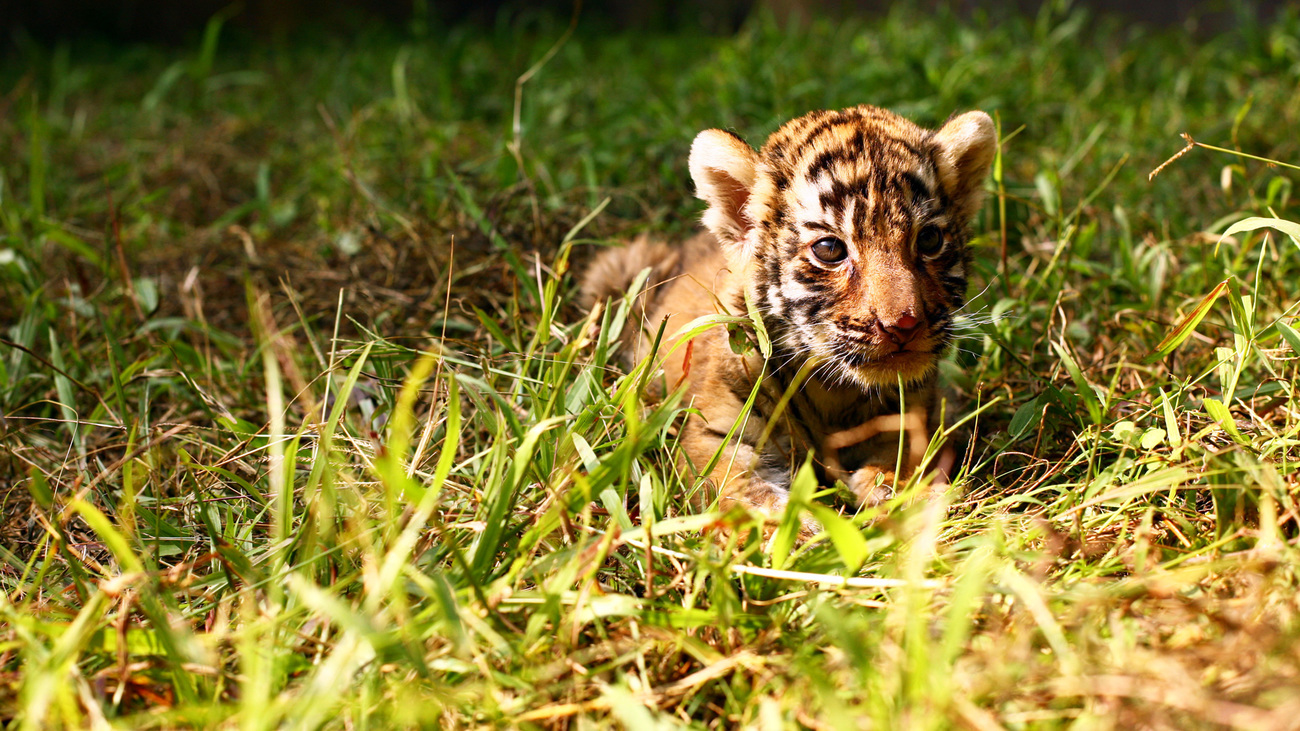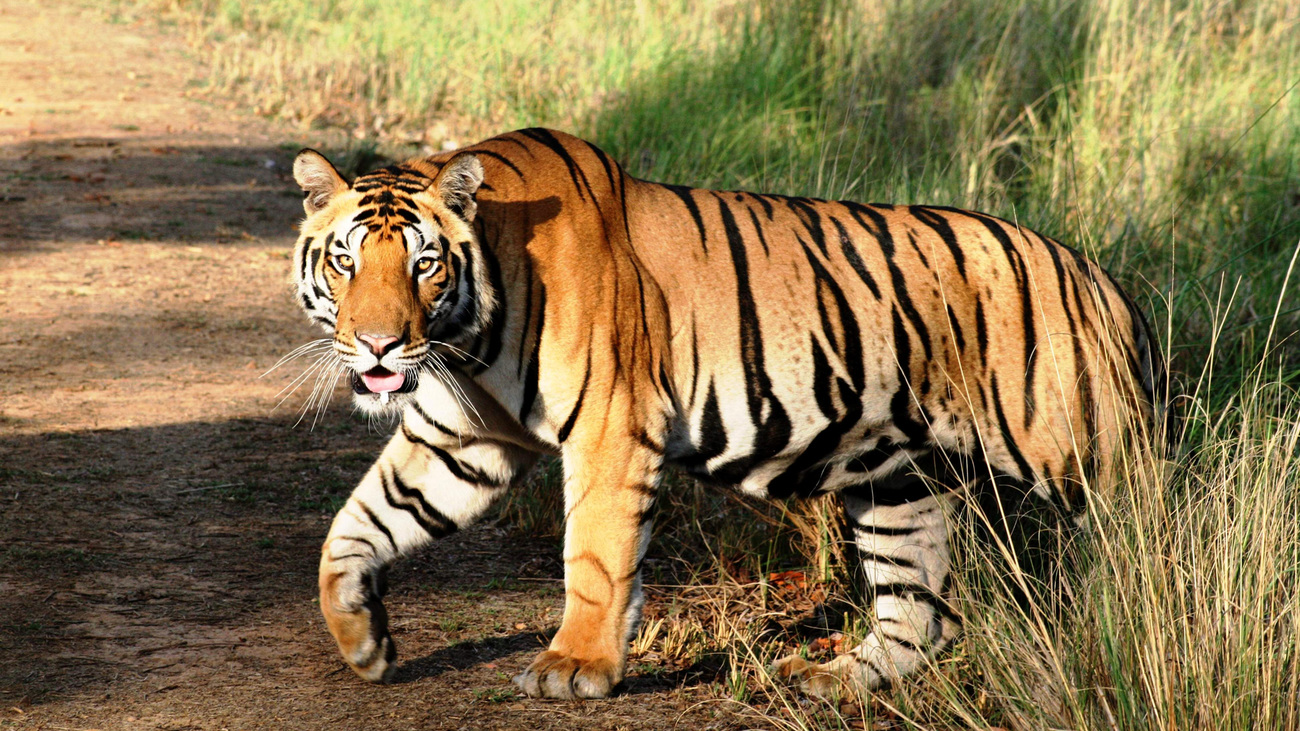Continental tigers
What is a continental tiger?
Continental tigers are a subspecies of tiger found in mainland Asia. This subspecies includes several different types of tiger, including:
- Bengal tigers
- Siberian tigers (also called Amur tigers)
- South China tigers
- Indochinese tigers
- Malayan tigers
- Caspian tigers (now extinct)
Tigers found on islands like Sumatra are not considered continental tigers.
Also known as mainland Asian tigers, continental tigers are covered in golden-orange fur with black stripes and are the largest big cats in Asia. Each tiger’s stripes are unique, much like a human’s fingerprint.
Despite common belief, white tigers are not a subspecies of tigers. They are Bengal or Siberian tigers with a genetic mutation called leucism that causes a lack of pigment in their fur.
Continental tigers vary in size across the different subspecies. Amur tigers (also known as Siberian tigers) are the largest—males weigh up to 300 kilograms (660 pounds) and measure up to four meters (13 feet long) from their nose to the tip of their tail. These elusive tigers can only be found in one corner of far-eastern Russia and have a pale coat with brown stripes to blend in with the snowy landscape.
Bengal tigers are the most common continental tiger, making up about half the population of wild tigers across Asia. Caspian tigers were a continental tiger population native to eastern Turkey and Central Asia but were declared extinct in the mid-20th century after extensive habitat loss and hunting.
Tigers are carnivores and apex predators. They hunt and eat prey like deer, wild pigs, water buffalo, and antelope. However, they’ve been known to feast on other creatures, like monkeys, leopards, and even crocodiles.
They are solitary hunters, stalking their prey at night and ambushing them. Tigers can reach speeds of up to 45 kilometers per hour, but only for short bursts, so they rely on careful stalking to take down prey.
What is a continental tiger’s scientific name?
Panthera tigris is the scientific name for all tigers in general. The continental tiger subspecies is known as Panthera tigris tigris. Formerly, the specific populations within this subspecies were considered separate subspecies, and they held these scientific names:
- Bengal tigers: Panthera tigris tigris
- Amur or Siberian tigers: Panthera tigris altaica
- South China tigers: Panthera tigris amoyensis
- Indochinese tigers: Panthera tigris corbetti
- Malayan tigers: Panthera tigris jacksoni
- Caspian tigers: Panthera tigris virgata (extinct)
However, these tigers are now generally classed as one subspecies, using the scientific name Panthera tigris tigris.
Are continental tigers endangered?
Tigers, as an entire species, are endangered, and their populations are declining across the Asian continent.
The Caspian tiger has been extinct since the mid-20th century, while the South China tiger is possibly extinct in the wild, as it hasn’t been seen since the 1970s.
The remaining populations of continental tigers are dwindling quickly. The four remaining populations are listed by the IUCN as endangered, with the following reported populations left in the wild:
- Amur or Siberian tiger: fewer than 600 left in the wild
- Indochinese tiger: around 250 left in the wild
- Bengal tiger: 2000-2500 left in the wild
- Malayan tiger: fewer than 150 left in the wild
Where do continental tigers live?
Continental tigers live throughout the Asian mainland, in India, Nepal, Bhutan, Bangladesh, Myanmar, Russia, China, Thailand, Malaysia, Cambodia, Laos, and Vietnam.
They live in various habitats across the continent, adapting to everything from rainforests, grasslands, and savannas to mangrove swamps.
- Bengal tigers inhabit the forests and wetlands of India, Bangladesh, Bhutan, and Nepal.
- Siberian tigers can be found in the cold-climate forests of far-eastern Russia and northeastern China.
- South China tigers were once found in the forests of southern China, but now they’re likely extinct in the wild and are only found in captivity.
- Indochinese tigers are native to the tropical and subtropical forests of Southeast Asia.
- Malayan tigers live only in Malaysia, in tropical forests.
- Before going extinct, Caspian tigers were found from Turkey through Central Asia to northern China, with the most extensive range of any tiger subspecies.
Threats
Tiger populations face multiple threats, ranging from climate change and habitat loss to poaching and hunting. These are the most common threats of which conservationists need to be aware to protect continental tigers.

Poaching
Poaching is the most significant threat faced by continental tigers, even more so than habitat loss. Tigers’ body parts are highly sought after by illegal traders. So many parts of a tiger’s body, from its whiskers to its bones, have been sold in illegal wildlife markets.
Tiger occupancy has declined by 53% since 1997, which scientists have primarily attributed to illegal poaching.
Habitat loss
Just like most endangered species on earth, tiger populations are threatened by habitat loss caused by various factors. In the last few decades, tigers have experienced considerable habitat loss, with scientists citing it as the second most prevalent reason for the sharp decline in tiger populations across the continent.
Human settlement, land-use changes, infrastructure expansion, urbanization, and agriculture all result in the removal of tigers’ natural habitat. This leads to population fragmentation, causing dwindling numbers and fatal inbreeding.
Human-wildlife conflict
As tigers’ habitats become smaller and more condensed, it becomes more likely that wild tigers will come into contact with humans living in rural villages or on farms. In India, 320 people were killed in tiger attacks from 2014 to 2020.
When tigers attack livestock or humans, humans retaliate with violence against tigers to protect themselves. Better education about the need to protect tigers and how to live alongside them peacefully could potentially reduce fatal human-tiger conflicts.
Climate change
Bengal tigers, the most common type of continental tigers, are under dire threat of extinction due to climate change and rising sea levels. Much of their habitat is just a few feet above sea level, and scientists predict that by 2070, there will be no suitable tiger habitat remaining in the mangroves of Bangladesh.
Temperature changes also affect Siberian tigers in the north of the continent, altering their habitats and reducing their available food sources. It’s expected that Siberian tigers will become extinct within 100 years.
Of course, as climate change accelerates, wildfires and other natural disasters are becoming more frequent, directly killing continental tigers and decimating their habitats.
Tiger farms
There are more tigers in captivity in the United States than in the wild. Across the US, as many as 10,000 tigers are kept as exotic pets or for entertainment purposes. They live in facilities masquerading as rescue sanctuaries and at unqualified roadside zoos operating with little oversight or accountability, where they are treated extremely poorly.
IFAW works tirelessly in the US to protect these tigers, establishing legitimate sanctuaries where rescued tigers can live and be rehabilitated.
FAQs
What is a white tiger?
Despite popular belief, white tigers are not a tiger subspecies. Instead, they are Bengal or Siberian tigers with a genetic mutation that causes a lack of melanin in their coats, making them white.

Are Malayan tigers extinct?
Malayan tigers are not extinct, though their population is very diminished. Estimates place the number of wild Malayan tigers at fewer than 150.
What is the Malayan tiger’s habitat?
Malayan tigers live in the tropical forests of the Malay Peninsula.
Are there tigers in Thailand?
Thanks to strong conservation efforts in Thailand, the country has the largest population of tigers in Southeast Asia. In 2010, Thailand established a national conservation project, which has proven incredibly successful.
How many Indochinese tigers are left in the world?
There are only around 250 Indochinese tigers left living in the wild.
Why is the Indochinese tiger endangered?
Indochinese tigers are primarily under threat from illicit poaching and habitat loss. Until the 1930s, they were hunted for sport and kept as exotic pets, severely reducing their numbers in the wild.
Due to habitat loss, Indochinese tigers are forced to live in areas closer to human settlements, leading to more human-tiger conflicts and reduced available prey.
How many Siberian tigers are left?
There are fewer than 600 Siberian tigers left in the wild.
How big is a Siberian tiger?
Siberian tigers are the largest of all tiger subspecies.
The largest male Siberian tigers can grow up to four meters (13 feet) long from nose to tail and weigh up to 300 kilograms (about 660 pounds).
Where do Siberian tigers live?
Siberian tigers have adapted to living in a cold climate and can be found in the snowy forests of far-eastern Russia and northeastern China.
Why are Siberian tigers endangered?
Like other Asian tigers, Siberian tigers face several threats, including poaching, logging, forest fires, falling prey populations, and a lack of genetic diversity.
Is the Caspian tiger extinct?
The Caspian tiger was declared extinct in the mid-20th century. Before the population decline, it was the subspecies of tiger with the most extensive range in Asia.
Why did the Caspian tiger go extinct?
The Caspian tiger went extinct due to poaching and habitat loss. This tiger subspecies was particularly vulnerable because they lived in deserts and had to live near water sources. They were drawn to the same areas where humans settled, leading to conflict.
As humans moved into their territory, they also ate the tiger’s food, depleting stocks of its prey species. This conflict and the development of their habitat edged them toward extinction.
In the first half of the 1900s, thousands of Caspian tigers were killed through poisoning and trapping, decimating their population before they eventually died out completely.
Where did the Caspian tiger live?
Caspian tigers inhabited a vast range from the westernmost point of Asia across the continent. These tigers were found from modern-day Turkey through much of Central Asia through to northwestern China.
Are South China tigers extinct?
South China tigers are likely extinct in the wild. They haven’t been seen by humans since the 1970s. The only remaining ones live in captivity.
Our work
IFAW works closely with partners, governments, and local communities to protect tigers.
In India, we work with the Wildlife Trust of India (WTI) in collaboration with the Assam Forest Department to help protect tigers living in Kaziranga National Park. Annual floods displace these animals, forcing tigers in the park to seek out higher ground for safety—often near or within neighboring communities. Our teams rescue tigers in need and provide them with lifesaving veterinary care.

IFAW-WTI has been working in Central India for over a decade, mitigating human-tiger conflicts, allowing safe passage to moving tigers, reducing human pressures on already fragmented corridors, and integrating stakeholder support in conservation management of tiger habitats. IFAW-WTI has also worked to strengthen protection for these big cats amongst other species by capacity building frontline staff (rangers), providing legal and enforcement assistance to wildlife enforcement agencies, and conducting anti-snare walks in critical tiger habitats.
In 2018, we helped launch the Coalition to End Wildlife Trafficking Online, a massive effort from conservationists and companies to help eradicate the online illegal market for exotic wildlife. Since then, online technology companies within the coalition have removed or blocked over twelve million online advertisements for endangered and threatened species, including tigers.
We work to protect tigers in the US too. In 2017, we established the Big Cat Sanctuary Alliance (BCSA), a network of sanctuaries that cooperate to ensure that captive tigers have a safe place to go when they are rescued. At the federal policy level, we also worked to pass the Big Cat Public Safety Act. This legislation, signed into law in December 2022, made private ownership of big cats and physical contact between the public and captive big cats illegal. As a result of these combined efforts, since 2003, we’ve rescued 189 captive big cats and placed them in legitimate sanctuaries.
How can you help?
You can help us build a better future for these endangered big cats.
